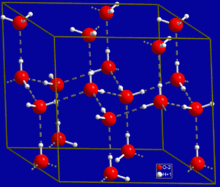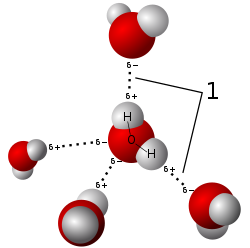Hydrogen bonds in water
The most ubiquitous, and perhaps simplest, example of a hydrogen bond is found between water molecules. In a discrete water molecule, there are two hydrogen atoms and one oxygen atom. Two molecules of water can form a hydrogen bond between them; the simplest case, when only two molecules are present, is called the water dimer and is often used as a model system. When more molecules are present, as is the case of liquid water, more bonds are possible because the oxygen of one water molecule has two lone pairs of electrons, each of which can form a hydrogen bond with a hydrogen on another water molecule. This can repeat such that every water molecule is H-bonded with up to four other molecules, as shown in the figure (two through its two lone pairs, and two through its two hydrogen atoms). Hydrogen bonding strongly affects the crystal structure of ice, helping to create an open hexagonal lattice. The density of ice is less than water at the same temperature; thus, the solid phase of water floats on the liquid, unlike most other substances.
Liquid water's high boiling point is due to the high number of hydrogen bonds each molecule can form relative to its low molecular mass. Owing to the difficulty of breaking these bonds, water has a very high boiling point, melting point, and viscosity compared to otherwise similar liquids not conjoined by hydrogen bonds. Water is unique because its oxygen atom has two lone pairs and two hydrogen atoms, meaning that the total number of bonds of a water molecule is up to four. For example, hydrogen fluoride—which has three lone pairs on the F atom but only one H atom—can form only two bonds; (ammonia has the opposite problem: three hydrogen atoms but only one lone pair).
- H−F…H−F…H−F
The exact number of hydrogen bonds formed by a molecule of liquid water fluctuates with time and depends on the temperature. From TIP4Pliquid water simulations at 25 °C, it was estimated that each water molecule participates in an average of 3.59 hydrogen bonds. At 100 °C, this number decreases to 3.24 due to the increased molecular motion and decreased density, while at 0 °C, the average number of hydrogen bonds increases to 3.69. A more recent study found a much smaller number of hydrogen bonds: 2.357 at 25 °C. The differences may be due to the use of a different method for defining and counting the hydrogen bonds.
Where the bond strengths are more equivalent, one might instead find the atoms of two interacting water molecules partitioned into two polyatomic ions of opposite charge, specifically hydroxide (OH−) and hydronium (H3O+). (Hydronium ions are also known as 'hydroxonium' ions.)
- H−O− H3O+
Indeed, in pure water under conditions of standard temperature and pressure, this latter formulation is applicable only rarely; on average about one in every 5.5 × 108 molecules gives up a proton to another water molecule, in accordance with the value of the dissociation constant for water under such conditions. It is a crucial part of the uniqueness of water.
Bifurcated and over-coordinated hydrogen bonds in water
It can be that a single hydrogen atom participates in two hydrogen bonds, rather than one. This type of bonding is called "bifurcated" (split in two or 'two-forked'). It can exist for instance in complex natural or synthetic organic molecules It was suggested that a bifurcated hydrogen atom is an essential step in water reorientation.
Acceptor type hydrogen bonds (terminating on an oxygen's lone pairs), are more likely to form bifurcation (it is called overcoordinated oxygen, OCO) than donor type, beginning on the same oxygen's hydrogens.
Acceptor type hydrogen bonds (terminating on an oxygen's lone pairs), are more likely to form bifurcation (it is called overcoordinated oxygen, OCO) than donor type, beginning on the same oxygen's hydrogens.


No comments:
Post a Comment